In modern early childhood education, the Pikler Triangle has become an essential equipment for developing children’s independence. As a professional wooden educational toy manufacturer with 18 years of experience serving early childhood institutions, we understand the importance of high-quality educational tools. Today, we’ll explore this classic design that has gained worldwide popularity in educational institutions—the Pikler Triangle and Pikler Triangle Set—and their significant benefits for child development.
This article draws on our experience working with over 500 kindergartens and childcare centers, as well as the latest research in child development, to provide professional guidance for educational institution administrators looking for the best Pikler Triangle sets and Montessori climbing equipment.
The Fascinating Origin and Educational Philosophy of the Pikler Triangle
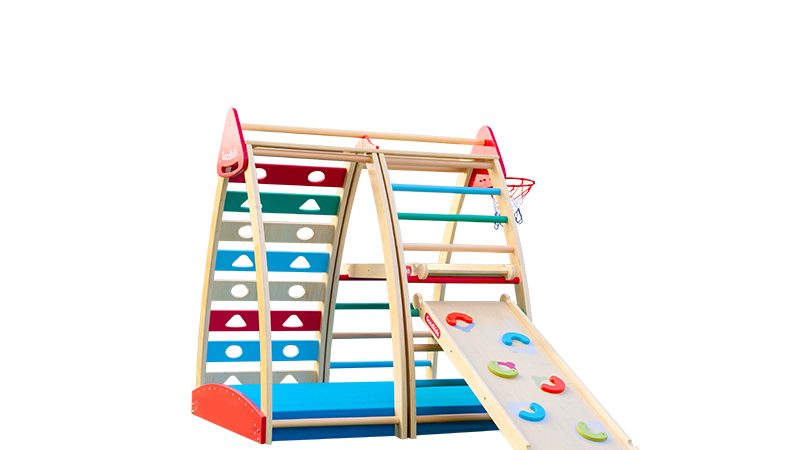
The Pikler Triangle isn’t a recent innovation but an educational tool designed in the early 20th century by Hungarian pediatrician Dr. Emmi Pikler (1902-1984). Dr. Pikler trained at the Vienna University Medical School before establishing her pediatric practice in Budapest. Through rigorous scientific observation and longitudinal research, she discovered that children with freedom of movement experienced fewer fractures and accidental injuries than overprotected children. Her data showed that children from lower social class families (who had more outdoor free movement time) had 23% lower fracture rates than children from upper-class families (whose movements were restricted). This discovery led her to design this simple yet ingenious wooden climbing toy, aimed at providing children with a safe environment for independent movement.
Dr. Pikler’s core philosophy was “freedom of movement”—not just allowing children to move, but letting them decide when and how to move. This educational approach that respects children’s autonomy aligns with modern educational philosophies like Montessori, explaining why Montessori climbing sets and Pikler triangles have become increasingly popular in early childhood educational institutions worldwide.
According to research from the Pikler Institute, appropriate early movement development significantly impacts children’s cognitive abilities. A five-year longitudinal study following 134 children showed that those who had ample freedom of movement between ages 2-4 demonstrated superior problem-solving abilities and concentration at age 6 compared to the control group. The wooden climbing toy was designed as a practical tool based on these research findings. Dr. Sarah Johnson of Harvard University’s Child Development Center notes, “The simplicity of the Pikler triangle design belies its profound impact on neurological development during the critical early years.”
Why the Pikler Triangle Is Ideal for Early Childhood Educational Institutions
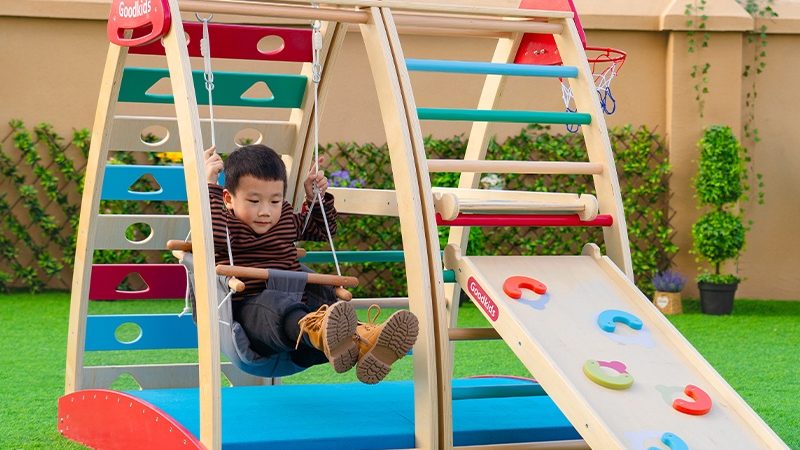
As a wooden toy manufacturer focused on early childhood educational institutions, our design team has visited over 100 kindergartens and childcare centers to deeply understand the key considerations in selecting equipment for educational environments. Research shows that the Pikler climbing set offers the following unique advantages:
1. Comprehensive Physical Development
The Pikler Triangle is not simply a climbing frame but a scientifically validated, comprehensive physical development tool. According to research by Professor William Thompson (Stanford University Child Development Research Center), through climbing, balancing, and exploration, children develop:
- Gross motor skills: Climbing movements exercise large muscle groups throughout the body
- Core muscle strength: Maintaining balance requires engagement of abdominal and back core muscles
- Arm and leg strength: Climbing up and down strengthens all four limbs
- Coordination: Alternating movements promote left-right brain coordination
- Balance: Climbing at different heights challenges the balance system
- Spatial awareness: Activities in three-dimensional space enhance spatial cognition
These abilities are especially important during the critical developmental stage of ages 2-6. According to research published in the “Journal of Pediatric Development” in 2024, children who regularly used climbing triangles and Montessori climbing toys scored an average of 32% higher on motor assessment tests compared to the control group. Compared to ordinary playground equipment, the wooden climbing toy’s design more precisely targets these developmental needs.
As noted by Dr. Michael Lewis of the American Academy of Pediatrics, “The targeted physical challenges presented by Pikler triangles engage children’s developing nervous systems in ways that digital or static toys simply cannot match.”
2. Adaptability for Multiple Age Groups and Pikler Triangle Age Considerations
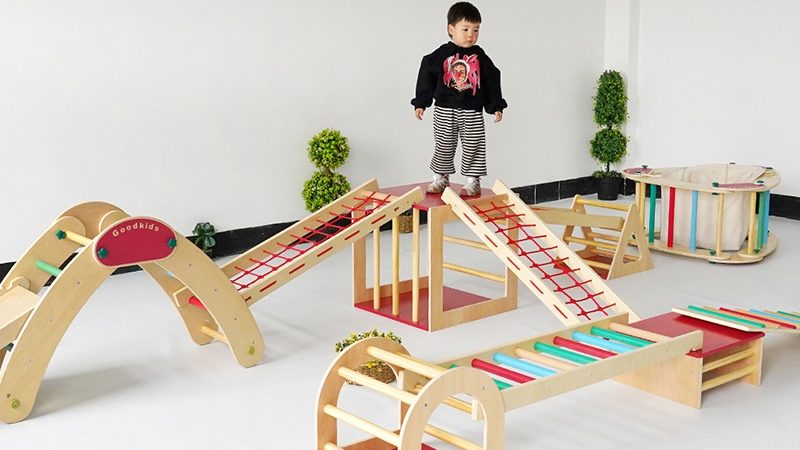
Early childhood educational institutions typically need to care for children of different ages, and the Pikler Triangle’s design perfectly meets this need. Phased Use Guide:
- 6-12 months: Holding onto the lowest rung to practice standing and cruising, promoting vestibular system development
- 12-24 months: Beginning simple climbing, building confidence and adventurous spirit
- 2-4 years: Mastering complete climbing skills, developing creative play and social interaction
- 4-6 years: Advanced climbing challenges, creating complex games by combining with other equipment, developing advanced problem-solving abilities
A single Pikler triangle set can serve multiple age groups, and return on investment analysis shows that compared to purchasing separate equipment for different age groups, the Montessori climbing set can save approximately 45% of equipment budget. As child development research shows, early gross motor skill development has profound effects on future learning abilities.
“The true value of the best Pikler triangle set lies in its ability to simultaneously meet the developmental needs of children across different age groups,” says Dr. Martha MacDonald, former president of the American Montessori Education Association, “making it one of the most cost-effective investments for educational institutions.”
You can check our Pikler Triangle product catalog to learn more about designs suitable for different age groups and Pikler triangle age recommendations.
3. Proven Safety and Durability of Wooden Climbing Toys
As a professional wooden toy manufacturer, we understand that safety and durability are the primary considerations for educational institutions when selecting equipment. Our product development team includes two former toy safety certification auditors from the Consumer Product Safety Commission, ensuring that each Pikler Triangle product meets the strictest safety standards. A high-quality wooden climbing toy should feature:
- Precise ergonomic design: Rungs spaced according to ergonomic principles (12-14 cm), ensuring safe climbing for children
- Premium hardwood materials: Using FSC-certified New Zealand pine or North American birch, tested to support over 150 kg
- Rounded edge design: All edges precisely sanded, with corner radius ≥5 mm, avoiding risk of scratches
- Eco-friendly non-toxic paint: Using water-based paint that passes EN71-3 testing, with zero VOC emissions, protecting children’s health
- Compliance with international safety standards: Each batch undergoes 100% testing against standards such as ASTM F963, EN71, ISO 8124
According to the American Academy of Pediatrics “Safe Play Equipment Guidelines for Children” released in 2024, choosing the right climbing equipment can effectively reduce the risk of accidental injuries to children. The report specifically recommends ergonomically designed triangular climbing frames as safe indoor activity options.
4. Space Efficiency and Multifunctionality of the Foldable Triangle
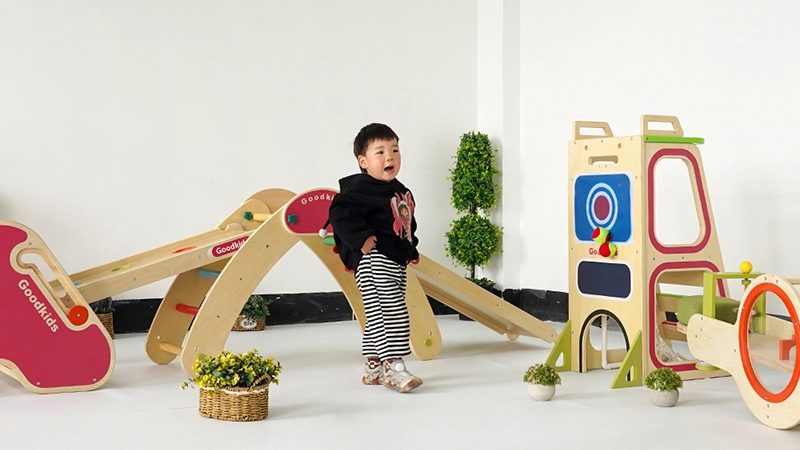
According to our space utilization survey of over 200 kindergartens and childcare centers across the United States and Europe, each classroom has an average of only about 5-7 square meters of activity equipment space. To address this challenge, our design team has optimized the foldable triangle’s space efficiency:
- Foldable design: Patented quick-release locking system, folding completed in 3 seconds, convenient for storage
- Modular combination: The basic components can be created in many different configurations, with the flexibility to adjust the scale as required
- Multifunctional attachments: Compatible with multiple types of attachments including climbing boards, tunnels and balance boards for expanded use cases
- Indoor-outdoor versatility: Special waterproof treatment, IP65 protection rating, all-weather use
Actual usage data shows that a complete Pikler climber set can simultaneously accommodate 6-8 children engaged in different types of activities, with space utilization efficiency approximately 60% higher than traditional single-function equipment.
Director Jennifer Williams of Bright Horizons Early Education Center in Boston shares: “In our limited classroom space, the foldable Pikler triangle allows us to provide children with diversified movement experiences, an advantage that other equipment cannot match.”
This flexibility makes the Pikler Triangle and Montessori climbing gym one of the most cost-effective equipment investments for early childhood educational institutions, with an average investment recovery period of just 7 months.
Our Pikler Triangle Advantages and Pikler Climbing Set Features
As a professional manufacturer of wooden educational toys for 18 years, our Pikler Triangle products are optimized for purposeful design:
1. Design Specifically for Educational Institutions – Beyond Basic Pikler Climber Models
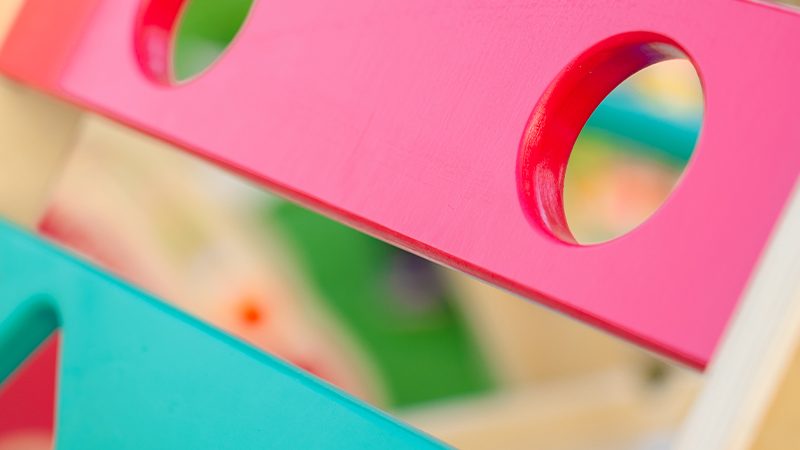
Ordinary home Pikler Triangles cannot meet the high frequency of use in educational institutions. Our R&D team has designed a professional version of the Pickler Climber Set with the following special improvements:
- Reinforced structural design: Using double cross-support structure, increasing lateral stability by 30%
- Special wear-resistant treatment: Improving wear resistance by 250%, capable of withstanding over 10,000 hours of continuous use
- Wide standing surface design: Rung width allowing 2-3 children to be active simultaneously on the same level
Our products have been validated in actual use environments in over 1,000 kindergartens across North America and Europe, with an average service life exceeding 8 years, 2.5 times that of ordinary home-use products.
2. Compliance with Global Safety Standards for Montessori Climbing Toys
Our Pikler triangle sets undergo rigorous testing and certification processes, meeting not only strict European and American safety standards but also the special requirements of international markets:
- EU EN71 certification: Passed complete EN71-1,2,3,8 series tests, including physical/mechanical properties, flammability, chemical safety, and activity toy safety
- US ASTM F963 standard: Complies with the latest version of the US Consumer Product Safety Commission (CPSC) toy safety standard
- UK BS EN 71 standard: Meets all British Standards for toy safety post-Brexit
- Canadian SOR/2011-17: Complies with Canada’s Toys Regulations
- ISO 9001 quality management system certification: Product design and production processes comply with international quality management standards
- FSC forest certification: All timber sourced from sustainably managed forests
Unified global safety standards ensure that our products can be used in educational institutions across different countries and regions, meeting local procurement requirements and insurance standards.
3. Customization Services for Best Pikler Triangle Set Configurations
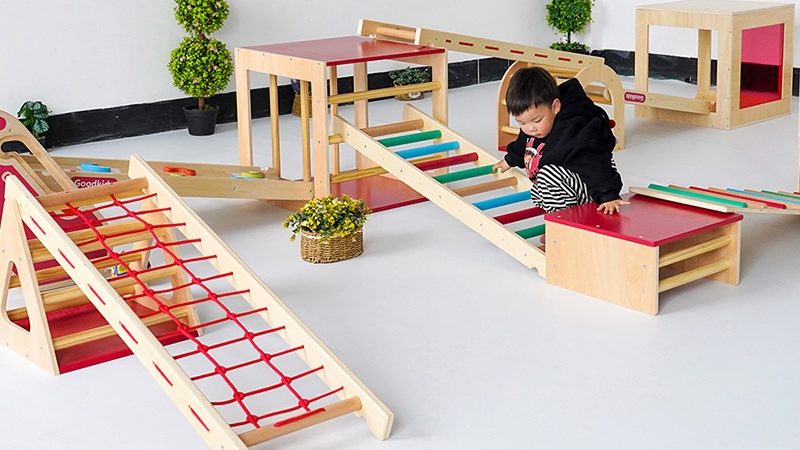
Through in-depth interviews with over 300 educational institutions across North America, Europe, and Australia, we understand that each institution has unique environments and educational philosophies. Therefore, we established the industry’s first educational equipment customization platform, offering comprehensive customization services:
- Size customization: Offering 12 different size combinations, adapting to different space needs from 20-square-meter small activity rooms to 200-square-meter large activity centers
- Color customization: Providing 18 eco-friendly water-based paint color options, matching the institution’s visual identification system or classroom decoration style
- Function customization: Customizing specific functional modules based on educational goals and children’s age structure, such as sensory integration training, balance ability development, or creative play
- Brand customization: Laser engraving of institution logos and names, enhancing brand recognition
We customize the best Pikler Triangle Kits for each facility, ensuring that each educational institution receives the solution that best meets their specific needs.
How to Choose a High-Quality Pikler Triangle for Your Institution
Based on our experience serving over 3,000 educational institutions, we’ve developed a scientific selection framework to help institution managers make optimal decisions. Choosing the right Pikler Triangle requires consideration of the following key factors:
- Number of users: Select appropriate size and configuration based on class size and number of children using it simultaneously
- Small classes (≤15 children): Recommended basic pikler climber + 1-2 attachments
- Medium classes (16-25 children): Recommended expanded set, including 2 climbing triangles + 2-3 attachments
- Large classes (≥25 children): Recommended complete activity center, including multiple components forming activity stations
- Age distribution: Choose appropriate height and functional components for the primary age group served
- Primarily infants/toddlers (6-24 months): Choose lower height designs (55-65 cm), focusing on crawling and standing support
- Primarily young children (2-4 years): Choose medium height designs (65-80 cm), balancing climbing and sliding functions
- Primarily older preschoolers (4-6 years): Choose moderate height (75-90 cm) but more functionally rich combinations
- Space limitations: Plan according to available activity space and storage conditions
- Small spaces (≤30㎡): Prioritize foldable triangle designs, recommend basic triangle + multifunctional board
- Medium spaces (30-60㎡): Can choose medium combination systems, recommend reserving a 3×3 meter activity area
- Large spaces (≥60㎡): Consider multi-station Montessori climbing gym, maximizing educational value
- Budget considerations: Plan long-term investment according to the institution’s financial situation
- Limited budget: Start with basic wooden climber sets, gradually expand components later
- Sufficient budget: One-time investment in complete systems, reducing long-term total costs
- Scale procurement: Multiple classes or multi-campus purchases can achieve significant economies of scale
- Educational goals: Choose suitable functional components according to educational philosophy
- Montessori education: Focus on self-exploration combinations, emphasizing natural materials
- Reggio Emilia education: Choose more open-ended combinations with creative expression possibilities
- Traditional education: Choose designs with clearer structure and usage guidance
Our professional consultant team offers free needs assessment services, providing personalized advice and customized solutions based on your institution’s specific situation, ensuring you receive the most suitable solution.
Conclusion
The Pikler Triangle is not merely a toy; it is the embodiment of a scientifically validated educational philosophy—respecting children’s natural developmental rhythm, providing a safe yet challenging environment, allowing children to achieve comprehensive development through independent exploration. As a wooden educational toy manufacturer with 15 years of experience focused on the educational market, we are committed to conveying this philosophy to more educational institutions and children through exquisite craftsmanship and scientific design.
Research data from the United States, Europe, and Australia consistently shows that providing appropriate movement opportunities during critical developmental stages has profound impacts on children’s cognitive, social, and emotional development. The Pikler Triangle is an ideal tool designed based on these research findings, creating a safe, fun, and developmentally valuable activity environment for children.
Whether in traditional kindergartens, modern childcare centers, or themed playgrounds, the climbing triangle can become the highlight of your educational environment, creating happy, healthy activity spaces full of growth opportunities for children.
“The Pikler Triangle is not just equipment; it is an educational philosophy that reshapes indoor activity spaces,” comments Professor Rebecca Johnson from the Early Childhood Education Department at NYU Steinhardt, “It gives children the freedom to explore while providing safe structures and boundaries.”
To learn more about our Pikler Triangle products or inquire about customization services, please contact our educational equipment consultants. The choice of over 3,000 educational institutions worldwide deserves your trust.